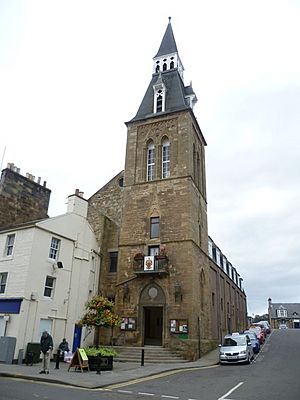Corn Exchange, Cupar facts for kids
Quick facts for kids Corn Exchange, Cupar |
|
|---|---|

Corn Exchange, Cupar
|
|
| Location | St Catherine Street, Cupar |
| Built | 1862 |
| Architect | Campbell Douglas |
| Architectural style(s) | Gothic Revival style |
|
Listed Building – Category B
|
|
| Official name: The Corn Exchange, Tower Only | |
| Designated | 1 February 1972 |
| Reference no. | LB24165 |
| Lua error in Module:Location_map at line 420: attempt to index field 'wikibase' (a nil value). | |
The Corn Exchange in Cupar, Fife, Scotland, is a historic building. It used to be a busy place where farmers and traders bought and sold grain. Today, it's a popular spot for community events like concerts and fairs. This special building is officially recognized as a Category B listed building, meaning it's important to protect.
Contents
History of the Corn Exchange
Building a Place for Trade
In the late 1850s, some local business people in Cupar had a great idea. They wanted to create a special place for farmers to trade their crops, especially corn (which often meant grain like wheat or barley). So, they formed a company called the "Cupar Corn Exchange Company." They raised money to build this important new center for the town.
One of the first people to support this project was a very important government official called the Lord Chancellor, John Campbell. The perfect spot for the new building was chosen at the corner of St Catherine Street and Castlehill.
Design and Construction
The first stone for the new Corn Exchange was laid in August 1861. A famous architect named Campbell Douglas designed the building. He chose the Gothic Revival style, which means it looked like old medieval castles and churches. It was built using strong rubble masonry (rough, uncut stones) and cost about £4,000, which was a lot of money back then! The building was finished in 1862.
The most striking part of the design was its tall, four-story tower facing St Catherine Street.
- The first level had a grand arched doorway.
- The second level featured a French door with a small balcony.
- The third level had a window with fancy, wavy carvings above it.
- The top level had two tall, narrow windows.
The tower was topped with a tall, pointed spire that had small windows called lucarnes. This spire, standing 136 feet (about 41 meters) high, quickly became a famous landmark in Cupar.
The side of the building facing Castlehill was simpler. It had small square windows on the ground floor and dormer windows (windows that stick out from a sloping roof) on the top floor. Inside, the main hall was huge, about 90 feet (27 meters) long and 50 feet (15 meters) wide.
From Trading Hub to Community Center
The Corn Exchange wasn't just for trading. It also hosted many events. For example, a big concert was held there on July 12, 1870, supported by a local volunteer army group.
However, towards the end of the 1800s, trading at corn exchanges became less popular. This was partly due to a tough time for farmers known as the Great Depression of British Agriculture. Because of this, the Corn Exchange started to be used more as a place for the community. It became a popular venue for all sorts of festivals, fairs, and concerts.
In 1961, the Cupar Town Council took over the building. Later, in 2016, a local heritage group called Cupar Heritage took ownership of the original company's records. Today, the Corn Exchange continues to be a vibrant center for community life in Cupar.
See also
- List of listed buildings in Cupar, Fife

